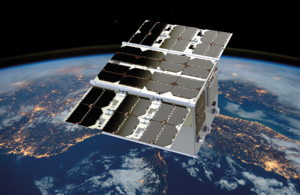Scout missions
Scout missions can prove new concepts using small satellites, which can then be scaled up in larger missions.

Credit: CubeMAP consortium
Scout missions are a new element in ESA’s Earth Observation Programme.
The idea is to prove new concepts using small satellites developed in a fast, agile manner, which add scientific value to data from current satellites.
The concepts can then be scaled up in larger missions.
The UK has won the competition to build and deliver the first two missions, which makes use of our strengths in building small satellites and our scientific expertise. These missions seek to deliver vital new information about our climate and environment in a new, faster, cheaper way.
Both missions are due for launch at the end of 2024.
Scout Mission: CubeMAP
Key features
The Scout CubeMAP mission will be a constellation of multiple separate CubeSats.
Its goal is to study, understand, and quantify processes in the tropical upper troposphere and stratosphere (UTS), particularly in the context of climate change and increased emissions in the tropics. The mission will provide insights on the composition of the UTS, study its variability, and its effects on climate and vice-versa.
In particular, the constellation will make observations in tropical and sub-tropical latitudes to observe aerosols and gases such as:
- water vapour
- carbon dioxide
- methane
- nitrous oxide
All of these play a key role in the greenhouse effect and climate change.
The mission is packed with novelty and innovation: a novel concept of measurement from a constellation is used to profile the atmosphere, for which the sun, the atmosphere and the satellite are aligned; and new instrument technologies enable miniaturisation and the use of nanosatellites.
The mission comprises three 12-litre cubesats, each carrying thermal infrared spectrometers, as well as a visible near-infrared hyperspectral solar disk imager as a secondary instrument.
UK involvement
The UK is the initiator and the scientific and payload lead of the mission. With the contract now signed, GomSpace in Denmark will lead an industrial consortium to build CubeMAP. The consortium includes Rutherford Appleton Laboratory (RAL) in the UK, GomSpace in Luxembourg and in Sweden, Enpulsion in Austria, Hyperion in the Netherlands and Kongsberg Satellite Services (KSAT) in Norway.
Scout Mission: HydroGNSS
With funding from ESA’s Scout programme, Surrey Satellite Technology Ltd (SSTL) is building HydroGNSS, a 55kg small satellite to measure climate change variables.

Credit: SSTL
Key features
The HydroGNSS satellite will take measurements of key hydrological climate variables, using a technique called GNSS Reflectometry, including:
- soil moisture,
- freeze thaw state over permafrost,
- inundation and wetlands, and above ground biomass
The purpose is to measure parameters directly linked to Essential Climate Variables (ECV) - key indicators that are used to describe the Earth’s changing climate on a global scale. Collectively, there are 54 ECVs which provide empirical evidence to support climate science and better predict future change. Of these, around 60% can be addressed by satellite data.
ECVs are specified by the Global Climate Observing System, a system that comprises the climate-relevant components of many contributing observing systems and networks.
Knowledge of these variables helps scientists understand climate change and the data is a valuable tool for many applications including weather modelling, ecology mapping, agricultural planning and flood preparedness.
Global Navigation Satellite System (GNSS) Reflectometry is a technique whereby signals from GPS satellites reflected off the land, ice and ocean and can be collected by a low-power receiver on a small satellite in low-Earth orbit, and used to yield important geophysical measurements.

Credit: SSTL
HydroGNSS paves the way for an affordable future constellation that can offer much more frequent, responsive measurements than is possible with traditional remote sensing satellite systems, offering a new ability to monitor very dynamic phenomena such as freeze and thaw cycles of permafrost and helping to fill the gaps in our monitoring of the Earth’s vital signs for the future.
UK involvement
Led by Surrey Satellite Technology Ltd (SSTL), working closely with partners at Sapienza, Tor Vergata and IFAC-CNR in Italy, FMI in Finland, IEC/IEEC in Spain, National Oceanographic Centre (NOC) in UK, and University of Nottingham to tackle the scientific and technological challenges involved. The mission and satellite are designed, built and operated in the UK by Surrey Satellite Technology Ltd.